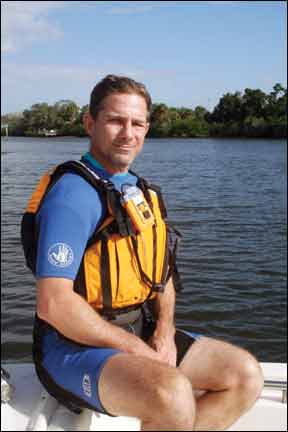
This months review of man-overboard devices that both alert the crew and help them track a person in the water is a pretty good opportunity for what I call fear factor marketing. Like any active sport that takes place on the water, sailing has risks, but many of the most persistent fears held by non-sailors (pirates are often high on the list) seem to be inspired more by fiction than fact.
The amount of risk one accepts is a personal choice, but it should be an informed choice, not an emotional response to an over-hyped fear.
Few things seem as horrifying as being unable to locate someone who has fallen overboard, or watching your boat sail away without you. Its an easy fear to stoke. But how likely is it? How much money should we spend to prevent it, and on what?
The risk of death from falling overboard is extremely low. It plummets if you are on a boat longer than 22 feet, havent been drinking, and know how to swim. These are just some of the facts you can glean from a study of man-overboard fatalities during a five-year period that was carried out by the BoatUS Foundation for Boating Safety and Clean Water. Theres a link to the report-as well as our own discussion of man-overboard recovery maneuvers-in the online version of this editorial at www.practical-sailor.com.
If we go by the foundations five-year total overboard fatalities (749) and National Safety Council data for various causes of death, the chance of me falling overboard and dying is about the same as me dying in a flood. Still, every year, we read about well-crewed boats losing crew overboard. These accidents are tragic, and it is understandable why a person would want do anything to prevent it from happening. But they are rare, even rarer are the incidents in which the inability to find the victim was a contributing factor. (Most accidents happen in calm waters.)
You wouldnt know this from reading the headlines about the Foundations MOB study or perusing the ever-growing field of MOB prevention and rescue equipment filling marine catalogs. Youd think that a leisurely sail on a millpond involved a constant battle to stay on board. When did a 30-foot Hunter become a kiteboard?
Bottom line: The new man-overboard transmitters we tested this month worked-with some key caveats. I wouldnt fully trust them in big seas, when their small antennas could flop underwater. And they need to be tested regularly, if you expect them to work. Despite these limitations, some people will find them to be a comforting addition to their arsenal for worst-case scenarios, and theyll be thankful to have them should the unthinkable occur.
Obviously, a man overboard transmitter is not a piece of gear we would recommend in lieu of more basic improvements, such as lifelines and handholds. Offshore, prudent use of a harness and tether takes priority, and MOB recovery procedures should be second nature. Alarms, MOB poles, and strobes can help, but at the end of the day, safety begins with basic seamanship. The old adage, One hand for yourself, one hand for the ship, is still the cheapest insurance around.






































